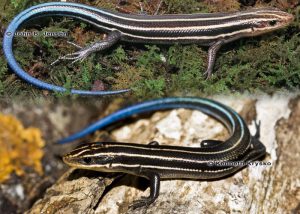 Q: My son is intrigued with the fast running lizards with the blue tails. They run too fast for us to get a real good look at them. They appear to be striped. What can you tell me about them?
Q: My son is intrigued with the fast running lizards with the blue tails. They run too fast for us to get a real good look at them. They appear to be striped. What can you tell me about them?
A: The creature you saw was probably the Southeastern five-lined skink, Eumeces inexpectatus but it could have been the Broad-headed skink, Eumeces laticeps or perhaps the five-lined skink, Eumeces fasciatus. The scientific name sounds like something right from a Harry Potter spell doesn’t it? I am not an expert herpetologist so it could be any of the three and they are difficult to distinguish from each other without looking at specific scale formations under the tail. It is unlikely that you or I would be handling them closely enough to determine scale formations.
The Southeastern five-lined skink is the most common skink found in Florida with the five-lined being the least common. Both five-lined skinks grow 6-8 inches in length whereas the broad-headed skink is the largest of the three reaching lengths of over 12 inches. Five-lined skinks may be found in almost any habitat, but are most common in wooded areas with an abundance of fallen trees and stumps to hide in.
Broad-headed skinks are more common along coastal regions but inhabit wooded areas as well. As you stated, they move incredibly fast. In fact, I had some difficulty getting a photograph of one in my yard. The body of the lizard is neutral gray, brown or black. The five stripes, from which its common name is derived, are white to cream colored. Young skinks have the distinctive bright blue tail, which caught your son’s eye. Once the skink reaches adulthood, the bright colored tail and stripes will fade. It will have a dull orange or red head but loses very little of its fast movement. They eat insects, spiders and small invertebrates; therefore we consider them beneficial animals to have around the landscape. Like many other lizards, they can lose their tail as a defensive mechanism.
 0
0
